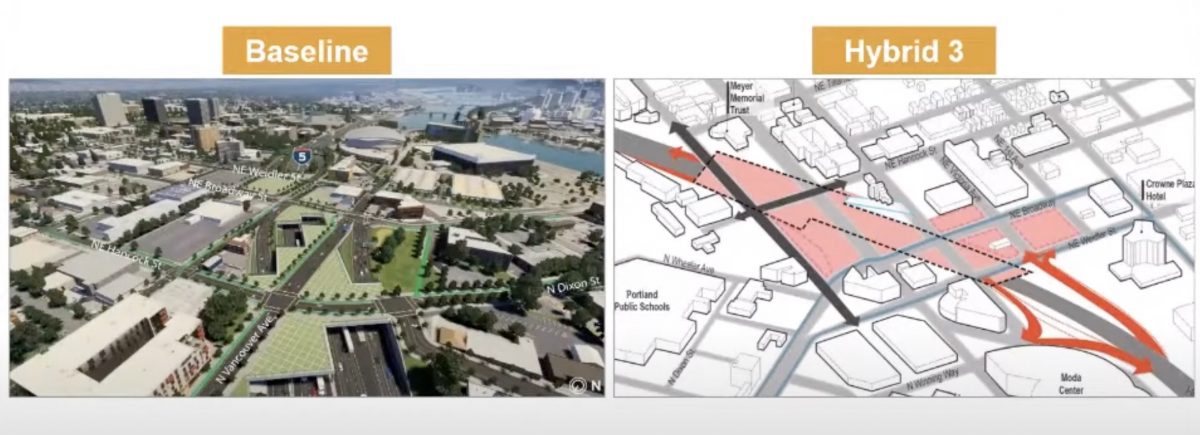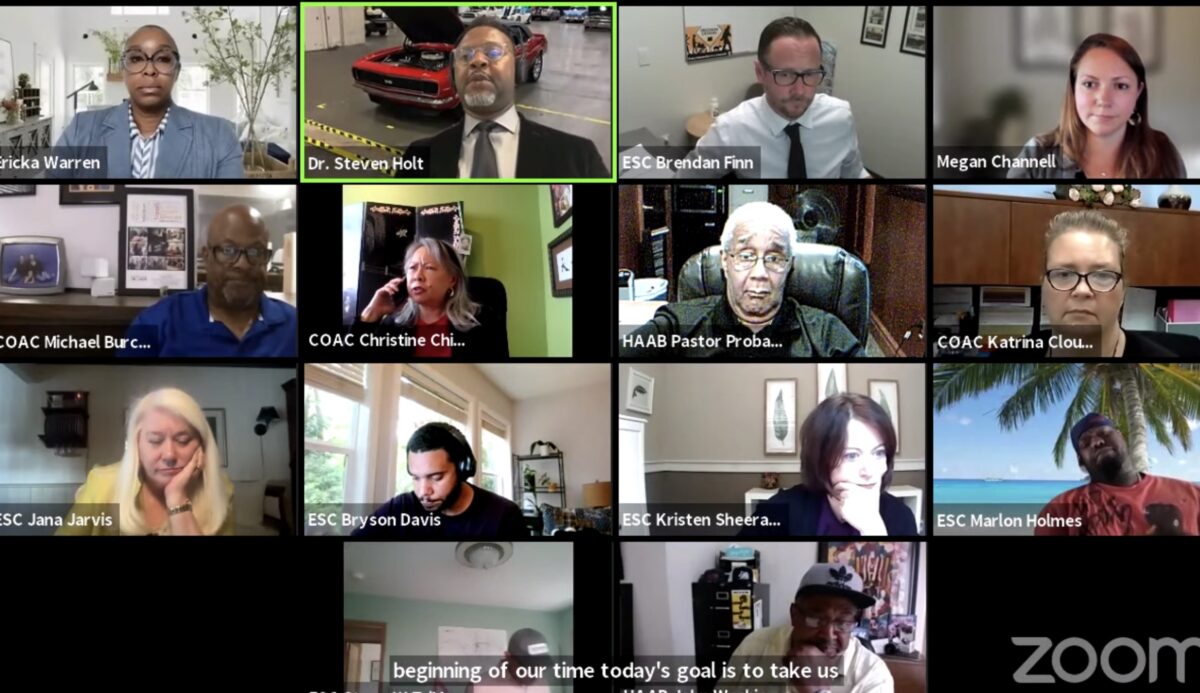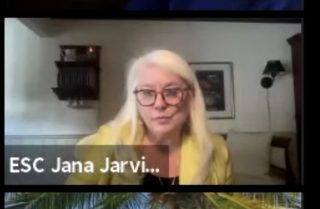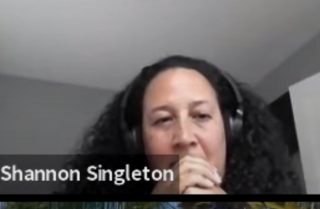“We’re talking a lot about restorative justice here, but those decisions were made decades ago and they certainly weren’t made by truckers or passenger vehicle owners.”
— Jana Jarvis, president of Oregon Trucking Assocations
At a meeting Tuesday night for the I-5 Rose Quarter project, people who seek restorative justice after their neighborhoods were decimated by the original construction of the freeway voiced frustration with the Oregon Department of Transportation for a lack of clarity around how exactly it would be meted out. At the same meeting, an influential trucking lobbyist appeared to marginalize the concept in a bid to absolve responsibility of truckers and car drivers from having to pay for it.
It all happened at a joint meeting of the project’s Executive Steering Committee (ESC), Community Opportunity Advisory Committee (COAC, which advocates for construction jobs) and Historic Albina Advisory Board (HAAB) hosted by ODOT. The agency called the groups together with the expectation that the HAAB would formally support the “Hybrid 3” option, a compromise design brokered by Oregon Governor Kate Brown that attempts to balance the state’s desire to keep the project timeline intact and show support for Albina neighborhood advocates’ vision for the rebirth of a thriving community over the freeway. ODOT’s initial plan included anemic covers that would only support open space, but HAAB members and other groups pushed for more robust covers that could support multi-level buildings (at least two stories, and possibly up to six).
But as we reported last week, while the Hybrid 3 option is acceptable to all stakeholders, it’s still just a concept and many thorny issues remain.
Given an opportunity to comment on the cover at the outset of Tuesday’s meeting, Oregon Trucking Associations President and chair of the City of Portland Bureau of Transportation Freight Advisory Committee Jana Jarvis said her constituents aren’t ready to fully support Hybrid 3. Their focus is to push for as wide of a freeway as possible. “It isn’t that we’re opposed to option three, particularly, but it’s premature to look for our support because there are a lot of unanswered questions,” Jarvis explained. Chief among them are: who will pay for the extra cost of larger covers (she feels truckers have already paid enough through increased taxes and shouldn’t have more financial burden from a larger cover), how the covers reduce the width of the freeway (“the whole reason we’re fixing that section of freeway hopefully, is to reduce congestion… Not to create opportunities for additional congestion”) and what exactly ODOT has planned for “restorative justice”.
Advertisement
Jarvis’ comments on that last point led to a mild rebuke from an advisor of Governor Brown’s Equity and Racial Justice Director Shannon Singleton. Here’s the exchange:
Jarvis:
“We’re talking a lot about restorative justice here, but those decisions were made decades ago and they certainly weren’t made by truckers or passenger vehicle owners.”
“I want to ask us to be careful about our comments. I can appreciate that there may be some disagreement on how and who’s responsible for restorative justice. But if you were sitting in this room and you benefit from white supremacy culture, I would ask that you be cautious about how you frame what restorative justice and undoing harm to the black community looks like.”
The idea of restorative justice has been made a top priority by every advisory group for the project. But what exactly it means in reality, and how this justice is executed on-the-ground is becoming a point of frustration and debate. Several HAAB members expressed concerns that there has been months of talk about restorative justice, but no action.
“We’ve had many, many, many conversations about restorative justice, and we use the terminology and are passionate about. But I have not heard one practical example of what it looks like,” said HAAB member and New Song Community Church Pastor Richard Probasco. “It’s a terminology that we’ve used incessantly, and it’s very frustrating… the thing we never get around to is, who’s going to pay for it? Where’s the money coming from? And so it’s a circle we go around and around, and quite frankly I’m dizzy.”
Advertisement

(Perhaps ODOT and other government agency leaders feel like restorative justice is a process-related promise fulfilled simply by listening to the community, while advisory committee members see it as something more tangible and equate it directly with jobs and programs and funding?)
Meanwhile, ODOT is getting impatient. The Hybrid 3 option is already a compromise for the agency. And while they’ve said it’s feasible and won’t throw off their plan to break ground in 2023, it was clear at the meeting they are feeling a sense of urgency to move forward. Because the ESC has committed to following the lead of the HAAB, ODOT hoped the HAAB would make a formal recommendation of Hybrid 3 Tuesday night. That’s because once the HAAB makes their recommendation, the ESC would then follow suit, then the design could move forward after adoption by the Oregon Transportation Commission (OTC) who are set to meet the first week in September. That’s a crunched timeframe.
“If we don’t have transparency about the conversations that are happening, there’s no way that this will be restorative.”
— Estelle Love Lavespere, HAAB member
Unfortunately for ODOT, only four of the 12 HAAB members were present Tuesday night. Without a quorum, members didn’t feel comfortable making any formal decisions. ODOT staff tried to suggest ways the recommendation could move forward regardless, but HAAB members stuck to their guns.
There was also HAAB member John Washington who mocked the process throughout the meeting by pointing out that Hybrid 3 is the only option on the table, so there really wasn’t a true choice being made. “Do we have other options? Y’all made it sound as if we had other options. And there weren’t any other options.” (In the end, Washington said he supports Hybrid 3.)
There were also rumblings of discontent with the process from HAAB member Estelle Love Lavespere, who voiced concern that the Hybrid 3 compromise was hashed out away from the HAAB. “That’s how hybrid three came about. [It] was the same people that sent us this letter [signed by Portland Bureau of Transportation Commissioner Jo Ann Hardesty, Multnomah County Commissioner Jessica Vega Pederson, and Metro President Lynn Peterson] saying, ‘Hey, we think this is how it should go’. And here we are. ‘Hey, pick Hybrid 3’. So now they’re saying, ‘Hey, this is how restorative justice should look like, you people wronged by this’….If we don’t have transparency about the conversations that are happening, there’s no way that this will be restorative.”

In addition to how restorative justice will be made real via the project, other upcoming debates are likely to center on what should be built on top of the covers, who will design them, and who pays for them. Jarvis with the trucking group has made it clear cost is a sticking point for their support.
ODOT Project Manager Megan Channell shared at the meeting that early cost estimates for the Hybrid 3 cover concept would increase the cost of the project by about 50% — from a top range of $795 million as currently designed, to as much as $1.25 billion with covers that can hold up to three stories. If it’s decided that the covers will have buildings up to six stories the cost could go up to $1.75 billion, Channell said.
One clear takeaway from last night is that while ODOT will get their desired support for Hybrid 3, there will be a long list of conditions attached.
“I just want to be clear, that just because there’s a letter supporting Hybrid 3, there’s also a letter supporting Hybrid 3 with a lot of ‘ands’, and that list could grow based on the HAAB’s recommendation,” Metro President Lynn Peterson shared at the end of the meeting.
In other news shared at the meeting, ODOT revealed that discussions and plans to move Harriet Tubman Middle School have already begun.
— Jonathan Maus: (503) 706-8804, @jonathan_maus on Twitter and jonathan@bikeportland.org
— Get our headlines delivered to your inbox.
— Support this independent community media outlet with a one-time contribution or monthly subscription.





